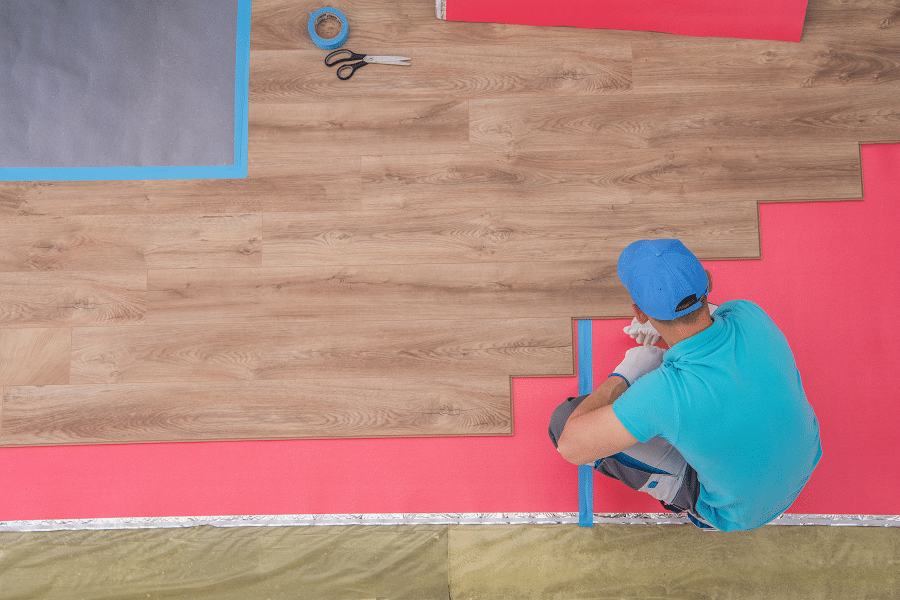When it comes to flooring, there are two main options: laminate and tile. Both have their own set of pros and cons, and it can be hard to decide which is the better option for your home. This article will take a look at the pros and cons of laminate flooring and genuine tile, so you can make an informed decision about which type of flooring is right for you.
Contents
Pros Of Laminate Flooring

- Laminate flooring offers a cost-effective alternative to genuine tile if you’re looking for something that’s low maintenance and easy to clean.
- There are no restrictions on the types of areas in your home where laminate flooring can be used, especially when protected by a moisture barrier.
- Laminate flooring is resistant to mold, mildew, and moisture, making it ideal for basements or bathrooms with potentially high humidity levels. It’s also great to use in kitchens where spills are common because it won’t stain easily like genuine tile would.
- Laminate flooring comes in a variety of styles and colors, allowing you to make a bold statement when decorating your home. There are also patterns available that mimic the authentic look of ceramic, porcelain, or slate tiles without costing nearly as much money.
- This type of flooring is very simple to install because it arrives in one sheet that can be cut into smaller pieces with a utility knife prior to installation for rooms such as closets or hallways.
Cons Of Laminate Flooring

- Laminate flooring is not as durable as genuine tile. It can be damaged by scratches, heat, and spilled liquids, so it’s best used in areas that don’t get a lot of foot traffic or heavy use, like the basement or bedroom.
- While many colors and patterns are available for laminate flooring, they’re generally categorized into three main styles: wood plank, stone, and ceramic tile. There may not be quite as much variety available with this type of flooring compared to what you find when choosing ceramic or porcelain tiles for your kitchen or bathroom.
- While laminate flooring is waterproof, it can be damaged if liquids remain on the surface of the floor for too long. Make sure to wipe up spills immediately using a non-abrasive cleaner and rinsing with clean water.
- Laminate flooring cannot be used where humidity levels are high such as in a bathroom or kitchen. Additionally, laminate floors should not be installed on an outdoor porch unless they’re protected by a moisture barrier and finished with multiple layers of paint or varnish.
Pros Of Tile Flooring

- Tile flooring is more durable than laminate and can be used in areas that have high humidity levels, such as bathrooms, kitchens, or even outdoors on a covered porch.
- Ceramic, porcelain, and travertine tiles are all suitable for use in living rooms, dining rooms, bedrooms, patios, entryways, or any other room in your home. The different types of available tile mean that you have many choices to match your personal style when decorating with this type of flooring.
- Tile has a high resistance to stains caused by mold and mildew, making it an ideal choice for basements with poor ventilation where humidity levels tend to run higher. While some care does need to be taken around spills or damp areas, it is generally easier to clean than laminate flooring.
- Tile floors are easy to install yourself if you have the right tools and materials available. This can save you money on hiring a professional to lay your new flooring versus using laminate.
- Because of its durability, tile flooring will last for many years without fading in color or becoming damaged by regular foot traffic.
Cons Of Tile Flooring

- Tiles can easily crack if exposed to extreme heat or cold. They may require sealing in order to protect them from humidity over time, which reduces the amount of water you can use to clean your floors. These two factors can increase overall maintenance costs.
- Ceramic, porcelain, and slate tiles cost much more money than laminate flooring due to their increased durability. While they come in many different colors and patterns as well, it’s unlikely you’ll find the same variety of colors and styles as available for laminate flooring.
- Ceramic, porcelain, and slate tiles require professional installation and must be sealed before use. They also tend to scratch more easily than laminate flooring, which may result in higher maintenance costs if your floors get a lot of traffic over time.
- Some types of tile, such as limestone or granite, can be more difficult to clean than laminate due to their porous nature. However, this does not apply to all forms of stone tiles, so it’s best to research the type you plan on purchasing beforehand if hardness is a concern for you when you make a decision about which type of tile is right for your home.
Conclusion
Tile flooring is a popular choice for homeowners because it is more durable than laminate, easy to clean, and comes in many different colors and styles. However, tile floors are more expensive than laminate and can crack if exposed to extreme heat or cold. Laminate flooring is a less expensive alternative to ceramic or porcelain tiles that scratches; heat can damage, and spilled liquids. The primary drawback of laminate flooring is its lack of durability-layers can be easily peeled off by either pets or furniture. Genuine tile has many benefits too-it’s more durable than laminate, cleans easily, and lasts longer. One downside to tile is the cost-while pricier than laminate; it’s cheaper than granite or marble floors.


